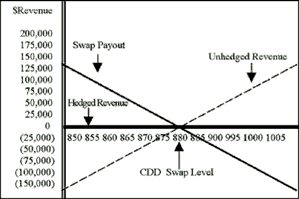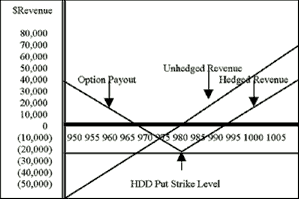Tradition brokers a full spectrum of weather derivatives via its Stamford, London and Sydney offices.
Below is an overview of the weather derivatives marketplace. To request more information, please contact the desks directly or send an e-mail to weather@tradition.com.
![]() Tradition uses Climetrix to price weather derivatives.
Tradition uses Climetrix to price weather derivatives.
- Tradition WEATHER PRICING LOGIN
- HDD and CDD Calculations HDD and CDD Swaps
- HDD and CDD Options
- Additional Trade Structures
- National Oceanic and Atmospheric Administration: www.noaa.gov
Market Information
Weather is more than just an environmental issue; it is a major economic factor: over one trillion dollars of the United States’ economy is weather sensitive. In 1997, Tradition expanded its services into weather derivatives thereby giving its clients the means to protect themselves from the uncontrollable forces of Mother Nature. Swaps and options, both plain and exotic in structure can be utilised by risk managers to hedge their weather risk exposure in a vast array of correlating markets. Energy companies, agricultural producers, garment manufacturers, the tourist industry and insurance underwriters are but a handful of industries that are concerned with the weather and its potential consequences.
HDD and CDD Calculations
All US temperature based trades are settled from data provided by the U.S. National Weather Service. Rainfall, snowfall, and reservoir levels can also serve as tradable indexes.
Heating degree days (HDDs) and cooling degree days (CDDs) are standard calculations used by energy companies. Based on a daily average temperature (e.g., daily high temperature plus daily low temperature divided by two), these numbers quantify energy demands to heat and cool respectively in a specific location.
Fahrenheit HDDs are calculated by subtracting the average temperature for a given day from 65°F. For example, a 45°F day results in 20 HDDs. Conversely, a 70°F day results in -5 HDDs, which is less than zero; therefore, the HDDs for that day will automatically default to zero, as no significant energy for heating is necessary. Celsius degree day calculations are made using 18°C as the base line temperature.
Fahrenheit CDDs use the opposite formula: subtract 65°F from the average temperature for a given day. For example, an 85°F day results in 20 CDDs. Conversely, a 60°F day results in -5 CDDs, again less than zero. Therefore, the CDDs for that day will automatically default to zero, as no significant energy for cooling is necessary. As was case with the Fahrenheit HDD calculation, Celsius degree day calculations are made using 18°C as the base line temperature.
HDD and CDD Swaps
HDD and CDD swaps are negotiated agreements between a buyer and seller to exchange the cash difference between a fixed rate (based on an agreed upon HDD or CDD level) and a floating rate (based on the actual HDD or CDD) for a specific location and time period. In essence, swap transactions can neutralise the effects of weather in relation to cash.
In the example below, a utility company that is concerned with a cooler than expected summer sells a CDD swap, which will pay-out a pre-negotiated sum (in this case $5,000) per CDD if the average temperature falls below 880 CDD’s for the period of July 1 through August 31.
Chart 1. CDD Swap (simplified)

Hedged revenue is constant with regard to temperature. At the end of the period, the utility would receive $5,000 for every degree-day below 880, which would offset a loss of revenue due to decreased demand for energy to provide cooling. Conversely, if the summer were hotter than normal, the utility would pay $5,000 for every degree-day above 880, offsetting again in revenue due to increased demand for energy to provide cooling.
HDD and CDD Options
An Option contract gives its purchaser the right, but not the obligation to enter into an underlying transaction at a pre-determined level on a pre-determined future date. For this right, the option purchaser pays a premium up-front to the option seller.
Call Options protect their buyer from higher HDD and CDD levels in a certain location over a certain time, while Put Options protect their buyer from lower than expected HDD or CDD levels.
In the example below, a utility company is concerned with a warmer than usual winter. They purchase a HDD Put Option for the period of February 1, 1999 through February 28, 1999 with a strike of 980 HDD’s, for a premium of $25,000 and a payout of $2,000 per degree-day.
Chart 2. HDD Put Option (simplified)

At expiration, if the Settlement Level is lower than the Strike Level, the option seller pays the buyer an amount that equals the Strike Level minus Settlement Level, multiplied by the pre-determined dollar amount. If the Settlement Level is higher than the Strike Level, the buyer’s maximum loss is the premium paid to the seller. Consequently, the seller pays out nothing and keeps the premium.
Additional Trade Structures
Tradition matches buyers and sellers in the full spectrum of weather derivative strategies; including monthly swaps, seasonal swaps, calendar spreads, simple options, zero cost and compound options. Besides temperature and precipitation (rainfall and snowfall), river flow and reservoir level indices can be used for derivatives. Tradition's service approach is tailored to individual customer requirements and aids in the efficient execution of the desired transaction.
London: +44 (0) 20 7198 1500
Stamford:
+1 203 351 9520
Tradition Energy: +1 877 517 6937
Sydney: +61 2 8076 8060